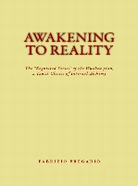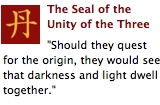Taoist Internal Alchemy
and the Awakening to Reality (Wuzhen pian)
Reproduced from:
Awakening to Reality: A Taoist Classic of Internal Alchemy
Translated by Fabrizio Pregadio
Golden Elixir Press, 2009
Paperback ● Kindle ● PDF
The Wuzhen pian (Awakening to Reality) is one of the most important and best-known Taoist alchemical texts. Written in the 11th century, it describes in a poetical form several facets of Neidan, or Internal Alchemy. Read more on this book.
 This page is part of a series on the Awakening to Reality. See the complete index.
This page is part of a series on the Awakening to Reality. See the complete index.
1. Zhang Boduan and His Work
Awakening to Reality (Wuzhen pian) is one of the most important and best-known Taoist alchemical texts. Written in the 11th century, it describes in a poetical form, and in a typically cryptic and allusive language, several facets of Neidan, or Internal Alchemy. Its author, Zhang Boduan, is also known as Realized Man of Purple Yang (Ziyang zhenren). As is common with many Taoist adepts, his biography combines fact and legend, and the dates of the main events in his life are not entirely certain. He was born in Tiantai, a district in the present-day southeastern province of Zhejiang, probably in 987. Having concluded his education with the highest degree, he undertook a career as an administrative officer in his district. Soon, however, he was accused of committing a major infraction in his duties and was punished with banishment to the remote south, in the Guangdong province. Around 1065 he moved to Sichuan, in the southwestern part of China, with an army commander that had hired him as advisor. While he was in Sichuan he met a master who transmitted alchemical teachings to him, and a few years later he wrote his work. Later he moved to the southern Yunnan province, where, having made sure that his work would survive him, he died in 1082.
Index of this article
1. Zhang Boduan and His Work
2. Doctrinal Sources
3. The Elixir
4. Cosmological Emblems
5. Final Remarks
Related pages
In addition to the Awakening to Reality, three other alchemical texts are attributed to Zhang Boduan:
1. Wuzhen pian shiyi (Supplement to the Awakening to Reality)
2. Yuqing jinsi Qinghua biwen jinbao neilian danjue (Alchemical Instructions on the Inner Refinement of the Golden Treasure, a Secret Text from the Golden Casket of the Jade Clarity Transmitted by the Immortal of Green Florescence)
3. Jindan sibai zi (Four Hundred Words on the Golden Elixir)
Although doubts have been cast on Zhang Boduan's authorship of these works, at least one of them, the Jindan sibai zi, bears a visible affinity to the Awakening to Reality in content and language.
Structure of the Awakening to Reality
All people on their own have the Medicine of long life; it is only for insanity and delusion that they cast it away to no avail.
![]() Wuzhen pian (Awakening to Reality, ca. 1075)
Wuzhen pian (Awakening to Reality, ca. 1075)
The Awakening is divided into three main parts, all of which consist of poems written in different meters. The first part contains sixteen poems written in "regulated verses" (eight-line heptasyllabic poems, known as lüshi). The second part contains sixty-four poems written in "cut-off lines" (four-line heptasyllabic poems, jueju). The third part contains eighteen poems, written in different meters and divided into three sets: one pentasyllabic poem, twelve "lyrics" (ci) of irregular length, and five more poems in "cut-off lines." The number of poems in each part of the work has a symbolic value. The sixteen poems in the first part represent the principle of the "two eights," which refers to the state of balance of the Yin and Yang components of the Elixir (see the note to Poem 7, lines 7-8). The sixty-four poems in the second part represent the hexagrams of the Book of Changes (Yijing; they are not, however, concerned with the hexagrams themselves). In the third part, the single pentasyllabic poem represents the original state of Unity; the twelve lyrics represent the twelve stages of the "fire phases" (the heating of the Elixir; see Poem 5, lines 5-6); and the final five poems represent the five agents (wuxing).
Zhang Boduan and the Southern Lineage (Nanzong)
 See an article on the Northern and Southern Lineages of Neidan
See an article on the Northern and Southern Lineages of Neidan
Since the time of its creation, the Awakening to Reality has enjoyed a wide circulation that has continued to the present day. In the 13th century, Zhang Boduan was placed at the origin of ☞ Nanzong, the Southern Lineage of Neidan, and his work became the main textual source of that lineage. Nanzong consists of a series of five masters whose works describe forms of Neidan closely related to one another (in addition to displaying similar formal features, such as the use of poetry). After Zhang Boduan, the lineage continues with Shi Tai (?-1158), the author of the Huanyuan pian (Reverting to the Source); Xue Daoguang (1078?-1191), the author of the Huandan fuming pian (Returning to Life through the Reverted Elixir); Chen Nan (?-1213), the author of the Cuixu pian (The Emerald Emptiness); and finally Bai Yuchan (1194-1229?), ascribed with the authorship of a large number of works and also known as a specialist of the Taoist Thunder Rites (leifa).
While transmission among the latter four masters is historical, Shi Tai was not Zhang Boduan's direct disciple. It is now understood that the Southern Lineage had, in its beginnings, no conventionally recognized form or structure, and was formally established as a lineage only at a later time, possibly by Bai Yuchan himself. The nomination of its five masters as the Five Patriarchs (wuzu) was inspired by the identical designation used within the Northern Lineage (Beizong), better known as Quanzhen or Complete Reality. Later, Li Daochun (fl. 1288-92) and Chen Zhixu (1290-after 1335), both of whom are among the greatest representatives of the Neidan tradition, took up the task of integrating Nanzong within Quanzhen. By their time, it was held that the anonymous master who gave alchemical teachings to Zhang Boduan in Sichuan was no other than Liu Haichan, the fourth (or fifth, according to different lists) patriarch of Quanzhen. Liu Haichan, in turn, was said to have received those teachings from Zhongli Quan and Lü Dongbin, both of whom were also included among the Quanzhen patriarchs. As a result of this conflation, Nanzong ceased to exist as an independent lineage and became part of Quanzhen. Its five masters and their texts, nevertheless, represent one of the most important forms of Taoist Internal Alchemy.
Next: 2. Doctrinal Sources ▶









